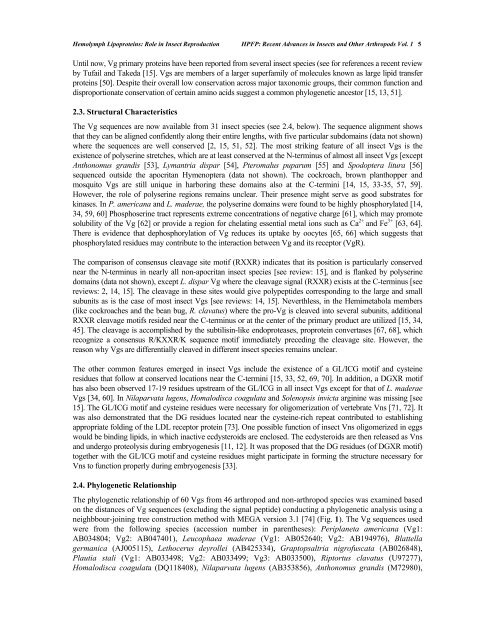chapter 1 - Bentham Science
chapter 1 - Bentham Science
chapter 1 - Bentham Science
Create successful ePaper yourself
Turn your PDF publications into a flip-book with our unique Google optimized e-Paper software.
Hemolymph Lipoproteins: Role in Insect Reproduction HPFP: Recent Advances in Insects and Other Arthropods Vol. 1 5<br />
Until now, Vg primary proteins have been reported from several insect species (see for references a recent review<br />
by Tufail and Takeda [15]. Vgs are members of a larger superfamily of molecules known as large lipid transfer<br />
proteins [50]. Despite their overall low conservation across major taxonomic groups, their common function and<br />
disproportionate conservation of certain amino acids suggest a common phylogenetic ancestor [15, 13, 51].<br />
2.3. Structural Characteristics<br />
The Vg sequences are now available from 31 insect species (see 2.4, below). The sequence alignment shows<br />
that they can be aligned confidently along their entire lengths, with five particular subdomains (data not shown)<br />
where the sequences are well conserved [2, 15, 51, 52]. The most striking feature of all insect Vgs is the<br />
existence of polyserine stretches, which are at least conserved at the N-terminus of almost all insect Vgs [except<br />
Anthonomus grandis [53], Lymantria dispar [54], Pteromalus puparum [55] and Spodoptera litura [56]<br />
sequenced outside the apocritan Hymenoptera (data not shown). The cockroach, brown planthopper and<br />
mosquito Vgs are still unique in harboring these domains also at the C-termini [14, 15, 33-35, 57, 59].<br />
However, the role of polyserine regions remains unclear. Their presence might serve as good substrates for<br />
kinases. In P. americana and L. maderae, the polyserine domains were found to be highly phosphorylated [14,<br />
34, 59, 60] Phosphoserine tract represents extreme concentrations of negative charge [61], which may promote<br />
solubility of the Vg [62] or provide a region for chelating essential metal ions such as Ca 2+ and Fe 3+ [63, 64].<br />
There is evidence that dephosphorylation of Vg reduces its uptake by oocytes [65, 66] which suggests that<br />
phosphorylated residues may contribute to the interaction between Vg and its receptor (VgR).<br />
The comparison of consensus cleavage site motif (RXXR) indicates that its position is particularly conserved<br />
near the N-terminus in nearly all non-apocritan insect species [see review: 15], and is flanked by polyserine<br />
domains (data not shown), except L. dispar Vg where the cleavage signal (RXXR) exists at the C-terminus [see<br />
reviews: 2, 14, 15]. The cleavage in these sites would give polypeptides corresponding to the large and small<br />
subunits as is the case of most insect Vgs [see reviews: 14, 15]. Neverthless, in the Hemimetabola members<br />
(like cockroaches and the bean bug, R. clavatus) where the pro-Vg is cleaved into several subunits, additional<br />
RXXR cleavage motifs resided near the C-terminus or at the center of the primary product are utilized [15, 34,<br />
45]. The cleavage is accomplished by the subtilisin-like endoproteases, proprotein convertases [67, 68], which<br />
recognize a consensus R/KXXR/K sequence motif immediately preceding the cleavage site. However, the<br />
reason why Vgs are differentially cleaved in different insect species remains unclear.<br />
The other common features emerged in insect Vgs include the existence of a GL/ICG motif and cysteine<br />
residues that follow at conserved locations near the C-termini [15, 33, 52, 69, 70]. In addition, a DGXR motif<br />
has also been observed 17-19 residues upstream of the GL/ICG in all insect Vgs except for that of L. maderae<br />
Vgs [34, 60]. In Nilaparvata lugens, Homalodisca coagulata and Solenopsis invicta arginine was missing [see<br />
15]. The GL/ICG motif and cysteine residues were necessary for oligomerization of vertebrate Vns [71, 72]. It<br />
was also demonstrated that the DG residues located near the cysteine-rich repeat contributed to establishing<br />
appropriate folding of the LDL receptor protein [73]. One possible function of insect Vns oligomerized in eggs<br />
would be binding lipids, in which inactive ecdysteroids are enclosed. The ecdysteroids are then released as Vns<br />
and undergo proteolysis during embryogenesis [11, 12]. It was proposed that the DG residues (of DGXR motif)<br />
together with the GL/ICG motif and cysteine residues might participate in forming the structure necessary for<br />
Vns to function properly during embryogenesis [33].<br />
2.4. Phylogenetic Relationship<br />
The phylogenetic relationship of 60 Vgs from 46 arthropod and non-arthropod species was examined based<br />
on the distances of Vg sequences (excluding the signal peptide) conducting a phylogenetic analysis using a<br />
neighbbour-joining tree construction method with MEGA version 3.1 [74] (Fig. 1). The Vg sequences used<br />
were from the following species (accession number in parentheses): Periplaneta americana (Vg1:<br />
AB034804; Vg2: AB047401), Leucophaea maderae (Vg1: AB052640; Vg2: AB194976), Blattella<br />
germanica (AJ005115), Lethocerus deyrollei (AB425334), Graptopsaltria nigrofuscata (AB026848),<br />
Plautia stali (Vg1: AB033498; Vg2: AB033499; Vg3: AB033500), Riptortus clavatus (U97277),<br />
Homalodisca coagulata (DQ118408), Nilaparvata lugens (AB353856), Anthonomus grandis (M72980),

















